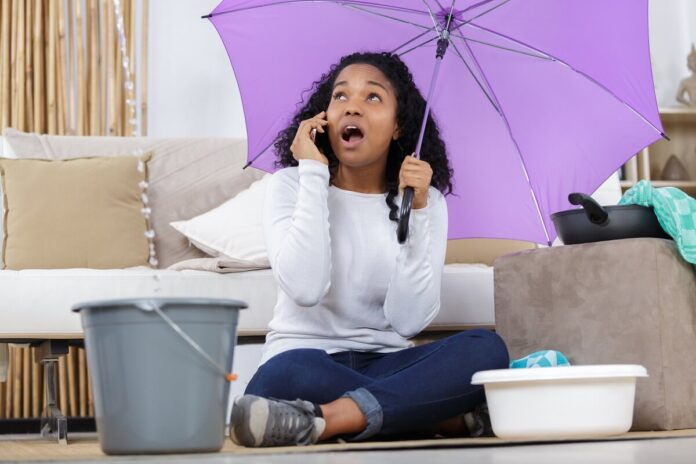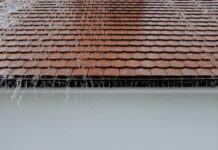Damaged roofs can make staying indoors uncomfortable. Imagine enjoying your time while watching your favorite shows with family and friends. Suddenly, you realize water is leaking through the roof, and everything is soaking wet. This can lead to the destruction of essential things in your house like electronics or furniture.
Before you get to such a point, you should inspect your roof to spot the areas that may be damaged and think of how to fix the issues. Keep in mind that doing such earlier checkups helps salvage the problem before it worsens and costs you an arm and a leg.
The Challenge
Spotting a damaged roof earlier can be difficult because, in most cases, the leaking spot isn’t always aligned with where the water stains appear on your ceiling. This is because water can enter the roof at one point and flow to another area before it begins to pool, soak, and cause discoloring on the ceiling board. Thus, it may not always be straightforward to identify the leaking points.
For that reason, you’d want to engage reliable roof contractors such as Arlington roof replacement or other similar ones to inspect your roof and advise you on the most appropriate course of action. They conduct a thorough indoor and outdoor roof inspection, looking at every spoiled shingle, crack, and missing roof part. The reliable ones have vast professional experience identifying roof damage and fixing it appropriately. They also sell roofing materials that are durable and can even withstand the harshest of weather conditions.
Signs Of A Damaged Roof
You must be aware of the tell-tale signs you should look out for so you know when to call a roof contractor for further diagnosis. Below is a detailed outline of signs of a damaged roof:
1. Water Stains And Streaks
This is perhaps the most obvious sign of a damaged roof. You may notice yellow, gray, or brown streaks on your white ceiling board, which is usually a sign of water leaking through the roof. The unsightly stains will appear at the center of where the water pools. Although flat, the ceiling forms natural depressions where water flows to.
Remember, by the time water percolates through the board and shows on the interior side, it must have been leaking for quite some time. So, take it as a matter of urgency. Otherwise, buying time may lead to considerable destruction of the ceiling board.
2. Increase In Electricity Bills
A leaking roof compromises your home’s energy efficiency, leading to higher energy bills as the air conditioning system struggles to keep the interior warm or cool.
3. Roof Leaks
If you don’t have a ceiling, water may leak directly through the defective roof and drop to the floor, forcing you to place several containers at the affected spots to trap the water and stop it from damaging your floor and household appliances. You must look at your roof problem immediately before it becomes a bigger problem. Doing repairs timely saves you from spending a lot of money on installing a new roof.
4. Marred Appearance
A quick visual inspection of the roof’s exterior side is enough to spot deformities, cracks, and sagging points. These signs mean that the roof has already become weaker, and it’s only a matter of time before it crumbles in.

5. Mold
If you notice mold growing on the exterior walls rising to the roof or on the wooden truss members, it’s usually a sign of water flowing down the walls instead of into the gutter. Mold thrives in moist areas, and the roofing system becomes a perfect breeding ground for mold when there’s a leak. Interior mold infestation may also cause the allergic family members to react by sneezing constantly. Such signs should spring you into immediate action before further damage.
6. Light Shining Through The Attic
When you can see light streaks in your attic, it means the roof has holes. It’s easy to spot the exact problematic point since you can trace the light’s origin.
7. Loose Flashing
Flashing is added to the roof to protect the vulnerable roof seams. In this case, if the flashing becomes loose, water will begin to enter your roof seams. If you can detect such a problem earlier, you’ll protect your roof.
8. Ponding Water
You can assess your roof and check if there are any pools of water across your roof. You can do this immediately after heavy rain since it’s the only way you get the ponding water. This can help prevent the ponding water from collecting for long, causing rusting, and making your roof weak by creating holes.
Causes Of A Damaged Roof
Knowing the causes of roof damage enables you to be vigilant and take the necessary preventive measures. These include:
- Broken flashing seals
- Wear and tear due to age
- Irregular maintenance of the roof
- Excessive UV rays can destroy your roof if it’s of poor quality
- Extreme weather conditions such as strong winds, heavy rainfall, and snow
- Extreme heat causing cracks and punctures
- Ineffective roof drainage systems
- Physical damage through falling debris
Fixing Damaged Roofs
After spotting any signs of damaged roofs outlined above, you must take immediate action to stop the molehill from turning into a mountain. There are usually two options for roof damage—repair or replace.
Repairing is an excellent cost-effective method for minor defects. However, if the damage is extensive, it may be cheaper to replace the entire roof. Repairing sections of a badly damaged roof may be futile because it’ll soon revert to the damaged state. Your roofing contractor should advise you on the most feasible option, or you can search online for “commercial roofers near me” to explore potential solutions.
To prevent roof damage, consider the following maintenance practices:
- Seek professional roof contractors’ services for regular maintenance. They can identify potential problems and enforce appropriate mitigation measures before the defects develop.
- Don’t block roof ventilation.
- Regularly inspect the flashings.
- If you’re planting trees, ensure they’re far away from the house. This way, in case there’s a strong storm and the tree branches fall, they won’t be landing on your roof.
- If you note any missing shingles, replace them immediately.
Conclusion
Knowing how to spot a damaged roof and address the issues goes a long way to protecting your property from damage. You don’t have to worry about leaks since your roof will always be in good condition. Your winning point is carrying out regular inspections, preferably monthly or more frequently during heavy rains. For the best results, consider contracting a roofing contractor for regular maintenance. Solving roof problems before they get out of hand prolongs your roof’s lifespan and saves you a lot of cash.







































